#c Axial
Explore tagged Tumblr posts
Text

Drew some headshots of characters I've been meaning to provide some udpated art for.
Hopefully will try to do more as I descend back into the comfort of flight rising.
#my art#flight rising#fr art#c Valera#c Jesse#c Siren#c Jim#c Axial#c Ultra#c Cub#c Jack#c Pippin#c Suukyi#c Gawain#c Bones
8 notes
·
View notes
Text





Mercedes-Benz Vision One-Eleven, 2023. A sports car study that looks to the future whilst drawing on the Mercedes concepts from the past. It is powered by lightweight and compact axial-flux electric motor technology. The car uses augmented reality so that the driver can use headset to turn the entire car into a user interface allowing you to see through the A-pillars. The design references the C-111 concepts of the late 60s and 70s
#Mercedes-Benz#Mercedes-Benz Vision One-Eleven#Mercedes-Benz C-111#2023#futuristic#concept#prototype#EV#electric car#axial-flux ev#gullwing doors
284 notes
·
View notes
Text

Transmechanicus Xenologis Field Report
Study Log Entry: 961.M41
Subject: Planetary Survey of Nullius-57, Orkoid designation “Og”
By: Magos Xenologis Xanthor Vell (Excommunicated)
Location: Segmentum Obscurus, Uncharted Subsector
I. PLANETARY CLASSIFICATION
Imperial Registry: Nullius-57 (Unofficial)
Orkoid Designation: Og — interpreted as “Owned by / Property of” in local feral Ork dialect
Segmentum: Obscurus
Planetary Type: Oceanic-Terranic hybrid
Size: Approximately 108% of Terra’s equatorial diameter
Water Composition: ~80% of the planetary surface
Orbital Characteristics: One sun (G-class), two moons in stable orbit

(I gave up, I don’t know shit about how to draw ocean currents)
II. TIDAL AND CELESTIAL DYNAMICS
The gravitational interplay between Nullius-57’s two moons creates unusually complex tidal patterns across the planet’s oceanic surface. These include:
• Multi-directional tidal surges
• Semi-diurnal hyperwaves in coastal and archipelagic zones
• Periodic tidal inversions recorded every 31 standard cycles, potentially responsible for cyclic mass migrations among aquatic fauna.
The planet lies within an uncharted zone of Segmentum Obscurus, likely masked from long-range Imperial auspex by stellar anomalies and warp turbulence—an ideal breeding ground for unrecorded evolutionary branches.
III. ATMOSPHERIC CONDITIONS
Atmospheric Density: ~1.3 atm (approx. 30% denser than Terra)
Primary Composition:
• Oxygen: 25–27%
• Carbon Dioxide: 3–4%
• Nitrogen, argon, and trace exotic gases
The thick, oxygen-rich atmosphere contributes to:
• Enhanced metabolic efficiency among local xenos species
• Higher combustion rates and volatile respiration thresholds
• Amplified fungal spore propagation due to sustained humidity and pressure
IV. PLANETARY GRAVITY AND FAUNAL ADAPTATION
Gravity: Approx. 0.38g (similar to Mars)
Despite the low gravity, native organisms have adapted in ways that defy standard models:
• Most fauna exhibit eight-limbed arthropodal symmetry, maximizing traction and momentum in low gravity
• Chitinous exoskeletons are dense and layered, likely evolved to compensate for the reduced structural strain
• Muscle fibers in larger fauna (e.g., Gargantuan Hammerfist Champignat) are hypertrophied and heavily vascularized, allowing for sudden explosive bursts of movement uncommon in similar gravity environments
The most significant observation remains the presence of Orkoid species as the only vertebrates. Whether artificially introduced or the result of a rare fungal-vertebrate divergence is still unknown, but their survival and dominance suggest a biome unusually hospitable to Ork physiognomy.

V. GEOLOGICAL STRUCTURE
Tectonics: Mildly active. Continental plates are fragmented but remain in proximity, indicating a prior supercontinent stage reminiscent of Terra’s Permian Pangaea.
Seismic scans reveal:
• Major fault lines still align radially around a central continental cluster
• Shallow subduction zones suggest ongoing but non-catastrophic geological drift
• Volcanic vents support a thriving thermophilic fungal biome, primarily near the equator
VI. CLIMATIC ZONES
Overall Climate: Humid and warm with minimal axial tilt, resulting in very limited seasonal fluctuation
• Equatorial Regions: Tropical with intense fungal overgrowth, average temperatures exceeding 34°C
• Polar Regions: Only moderately cooler, sustaining dense fungal tundra variants
• Rainfall: Near-constant in some biomes due to atmospheric pressure and oceanic evaporation patterns
VII. PLANGUS FLORAL BIOME (FUNGAL-PLANT EQUIVALENT)
Termed “Plangus” by my own designation—a portmanteau of planta and fungus—this fungal flora fulfills all major ecological roles of photosynthetic plant life.
Photosynthesis-analog Process:
• Utilizes green and blue pigmentation in chlorophyll-analog proteins (tentatively classified as Mycophytochrome-X)
• Plangus spore sacs open during peak solar periods to engage in gas exchange and UV absorption
• Bioluminescent varieties assist in nocturnal photosynthesis via energy storage in phosphorescent organelles
Color Morphology by Region:
• Highlands: Deep green and violet Plangus carpets, heavily mossed
• Lowlands: Amber, red, and orange fungal caps with wide lamellae for water retention
• Equatorial Swamps: Translucent white and yellow luminescent fungal towers, growing up to 40 meters
These fungal flora are crucial to nutrient cycling, oxygen production, and even psychotropic symbiosis observed in some mollusk-xenos.
VIII. LOCAL FAUNA
The dominant faunal archetypes fall into two categories:
• Arachnid/Insectoid Xenos: Eight-legged, armored, ranging from micro-scale scavengers to titanic apex predators such as the Gargantuan Hammerfist Champignat
• Molluscoid Xenos: Ambulatory, highly adaptive, semi-amphibious; many exhibit Plangus symbiosis for healing and camouflage
Orks:
The only vertebrate genus present, suggesting:
• Exogenic seeding (possibly via crashed hulk or rogue Sporeship)
• Exceptional fungal adaptation due to their own mycoid origin
Local tribes of feral Orks claim sole ownership of the planet, hence the name Og. This linguistic possessiveness hints at a deep instinctual bond between Orks and this fungal-rich environment, perhaps even more intense than typically observed on Ork-held worlds.
CONCLUSION
Nullius-57, or Og, is a world defined by a dense atmosphere, low gravity, and a unique fungal biosphere whose adaptive extremity borders on the miraculous. Its faunal and floral life appear to have evolved in tight biological concert, and the complete lack of vertebrate diversity—barring the Orks—raises fascinating evolutionary and possibly technogenic questions.
I suspect the planet may have once served as an ancient fungal cradle world, or perhaps even a lost Ork spawning ground from millennia past. In either case, Og is not merely owned by the Orks—it thrives because of them, and perhaps they because of it.
End of Entry
Magos Biologis Xanthor Vell
In Defiance of the Omnissiah, In Pursuit of the Green Truth
#warhammer 40k#my art#orks40k#ork world building#worldbuilding#scifiart#drawing#worldbuilding project#digital art
18 notes
·
View notes
Photo

Quran
The Quran (also written Qur’an or Koran), written down in the 7th century, is the sacred book of Islam, following in the tradition of the Abrahamic faiths, with the Torah as the sacred book of Judaism and the New Testament as the sacred book of Christianity.
Tarif Khalidi, a Palestinian historian who was formerly Sir Thomas Adams’ Professor of Arabic at Cambridge University and currently holds the Shaykh Zayed Chair for Arabic and Islamic Studies at the American University of Beirut says:
The Qur’an is the axial text of a major religious civilization and a major world language. For both Islamic civilization and the Arabic language the Qur’an consecrates a finality of authority granted to few texts in history.
(Khalidi, ix)
The Revelation
For the Muslim faithful, the Qur’an contains the verses of the word of God as revealed in the Arabic language to the Prophet Muhammad (also written Muhammed, c. 570 – 632) over the course of 22 years from approximately 610 to 632. The word qur'an derives from the Arabic verb qara'a meaning to read or recite. The very first Sura (chapter) revealed to the Prophet Muhammad while he was on a spiritual retreat in a cave was:
In the name of God,
Merciful to all,
Compassionate to each!
Recite, in the name of your Lord!
He Who Created!
He created man from a blood clot.
Recite! Your Lord is most bountiful.
He taught with the pen.
He taught man what he knew not.
Sura 96 The Blood Clot, Aya (Verses) 1-5 (Khalidi trans, 515)
Key texts within the tradition of Islamic heritage, the sayings, hadith (reports), and stories that form the sunna, a record of the Prophet’s life, recount the occasion of the revelation of the Qur’an to the Prophet on the Night of Power, Laylat al-Qadr – generally attributed to the 23rd or 27th night of the month of Ramadan – sacred to Muslims. In the year 610, at 40 years of age, Muhammad sat in meditation in the cave of Mount Hira and was approached by the angel Gabriel who ordered him: Recite! Muhammad was unable to speak until the third time he was commanded and then recited the sura (chapter) 96 above. Unsettled by this encounter, Muhammad set out in search of his wife Khadija who wrapped him in a cloak to stop him from shivering.
Folio from Nurse's Qur'an (Mushaf al-Hadina)
Metropolitan Museum of Art (Copyright)
However, he then received the revelation of Surah 74, telling him to stand up and preach his message:
In the name of God,
Merciful to all,
Compassionate to each!
You who are enfolded in your garments:
Stand up and warn!
Magnify your Lord!
Purify your garments!
And abandon impurity!
And give not hoping to get more! Be steadfast to your Lord!
Sura (Chapter) 74 Enfolded, Aya (Verses) 1-7 (Khalidi trans, 486)
Continue reading...
26 notes
·
View notes
Text
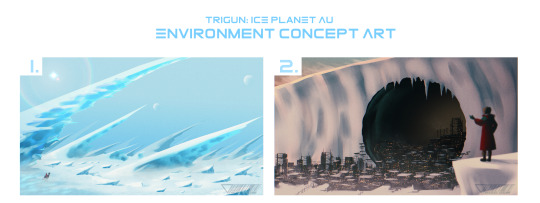


welcome to Hell Froze Over!
be glad youre not there :)
we have:
Ice Spike Regions areas covered in towering ice spikes. traveling through those regions is risky due to falling debris and strong winds.
Worm Tunnel Cities some cities/towns are built within the ancient tunnels of ice burrowing worms. theyre generally warmer thanks to their shape, which helps with even heat distribution.
The average snowstorm (and a crash-site city) sometimes also referred to as "the wrath of God", for uh.. obvious reasons (theyre big and scary and sooo deadly)
The Hunting Grounds general name of areas with high Icebreaker worm activity along the equator. the ice is much thinner there compared to the rest of the planet.
Ribbon Valleys places named after their characteristic striped icebergs.
Geothermal Areas (with stalker and flying worms) so far only two have been discovered. theyre the only places where the ice has melted enough for the ground to be visible. unfortunately theyre also known for being worm hotspots, thus hard to access.
+ some planetary scribbly stuff & ramblings below the cut

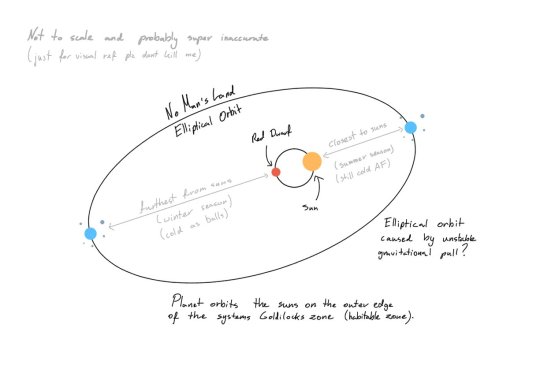
the planet is a frozen wasteland on the surface, covered in a thick ice shell that thins around the equator, with liquid water and a (possibly) volcanic seafloor deep below. theres very little land right under the ice and the planet would be a water world with few islands scattered about if not for the extremely low temperatures.
there are a lot of unknowns about whats going on below the ice since humanity doesnt have the equipment for that kind of research and everyone is too busy trying to survive the cold.
Hell Froze Over doesnt really have seasons like our planet does since its axial tilt is minimal. instead it has pseudo-seasons caused by its elliptical orbit.
its either cold or colder. the highest recorded temperature in the habitable zone was -34°C during the "summer" season. during winter it can drop all the way down to -90°C.
#trigun#trigun stampede#vash the stampede#if you squint#hes there just tiny#ice planet au#worldbuilding#andr0art#native wildlife post coming another time#im still figuring out how worms would work here#there are a lot of ways to adapt#anyway yeah lol#worldbuilding brainrot is strong#i have so much art for this eueueuueue#i refer to it as no mans land in the notes but the name hell froze over grew on me#its such a funny fucking name for a planet#i probably forgot some stuff so i may come back later to revisit this post#or just ask if you wanna know smth
356 notes
·
View notes
Text
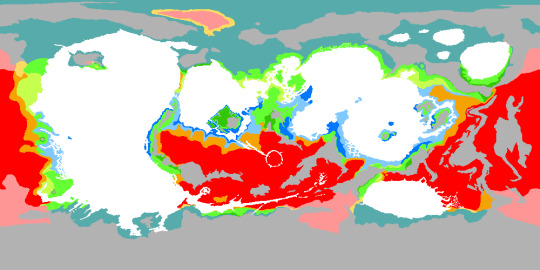
Approximate extent of climate zones on Qefre. Dark blue is rainforest, light blue tropical savannah; shades of green are temperate climates (Cxa/b/c on the Koppen chart), red and pink are arid, orange and beige are semiarid, gray is polar tundra/high altitude wasteland. The faded teal color is sort of a weird intermediate tundra I marked out because those regions definitely hit higher temperatures more frequently than the gray tundra, but on multiyear averages for temperature they still fall under the Köppen "tundra" classification, since these warm periods are erratic and intermittent.
There are a couple of quirks here: the planet's year is so short that despite comparable axial tilt to Earth (~25 degrees), there is very little seasonality to temperatures, especially near large bodies of water (and everywhere else is parched, so tends to dissolve into the all-encompassing "arid" or "cold arid" climate zones). The lack of distinct seasonality is why there aren't any mediterranean or monsoon climates, and why there's a sort of weird intermediate tundra climate instead of real continental climates. In our world, continental climates tend to be pretty heavily forested; in those regions on Qefre, you don't get growing seasons long enough (or with enough consistency) to support large plant growth, so I don't think they fit in with the spirit of the traditional continental or subarctic Köppen criteria. Some of the highland regions are very high--Dahar Mons is over 10 kilometers tall, which is airliner cruising altitude, making its summit more Martian than anything else.
Qefre's average temperature is ~15 degrees, so comparable to Earth; the equatorial deserts regularly get as high as 50 degrees, and the polar wastes as low as -55. Several of the regions in gray probably have small ice caps, especially in the southern highlands.
15 notes
·
View notes
Photo





Planet Zephyria, distinguishable from space by its vibrant violet hues, exists enveloped in a thin mist of amethyst clouds, casting a perpetual twilight across its surface. Approximately the size of Neptune, its atmosphere comprises rare xenon and argon gases, contributing to the vivid coloration visible from orbit. The surface is dominated by expansive forests of towering crystalline structures, resembling earthly trees but formed from natural violet quartz. These crystal forests reflect and refract Zephyria's dim sunlight, creating a shimmering landscape that fluctuates in tone and intensity. The planet's unique axial tilt results in extreme seasonal changes in solar illumination, causing dramatic shifts in the forest's appearance. The temperature, relatively stable, hovers around -50°C, suggesting a tranquil yet frozen tableau untouched by the winds common in such environments. This stark and mesmerizing world thrives in isolation, a spectacle of natural crystallography and interstellar artistry.
#VioletCrystalForests#DeepSpaceBeauty#GalacticWonder#CelestialFoliage#AweInspiringNebulae#CosmicFlora#InterstellarScenery#MysticalSpaceGardens#AstroPhotography#SpaceArtistry
8 notes
·
View notes
Text

Hi, hello! Over two years ago, I did a little leisure project that culminated in a fictitious "Sonic Solar System." Turns out, I looked back on it and wasn't too pleased with how I made the planets back then, so I redid them all with different names and different stats!
Please note I did not include Earth/Mobius because it is more or less the exact same as in real life. Pretend it's between the second and third planets listed here!
Zaqar
(zah-KARR)
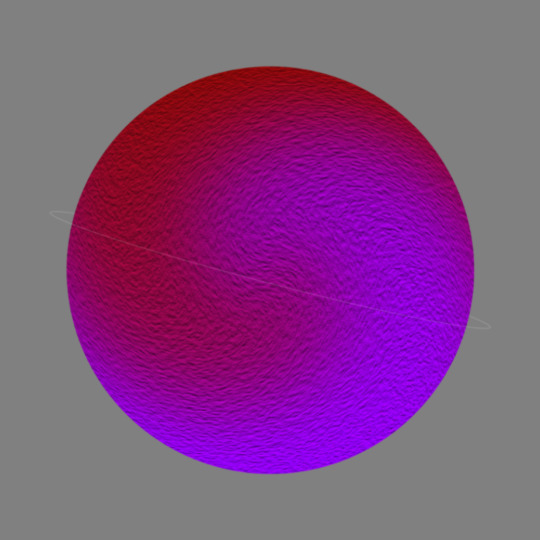
Planet type: Rocky furnace
Sky color: Swirling violet and blood red
Axial tilt: 14.6°
Moons: None
Planetary rings: 1 (small, near-invisible, made primarily of gas)
Size (in mass): 2.46 x 1021 tonnes (0.41x the size of Earth)
Radius: 1,623 miles (2,612 km)
Gravity: 0.92x Earth’s gravity
Temperature range: 372°C (701.6°F) to 562°C (1,043.6°F)
Average surface temperature: 467°C (872.6°F)
Water prevalence: None (too hot)
Earth life: Unsuitable for Earth-based life without additional support
Length of day: 55 hours
Length of year: 123 Earth days
Seasonal variations: Slight (temperatures vary only slightly based on the position of the planet over the year)
Namesake: Zaqar (aka Zaq-qar, Dzakar, Zaqiqu, or Ziqiqu), messenger and sukkal of the moon god Sin in Mesopotamian mythology
Fun fact: Zaqar is the only planet in the inner Solar System to have a ring system
Ambika
(AHM-bik-ah)
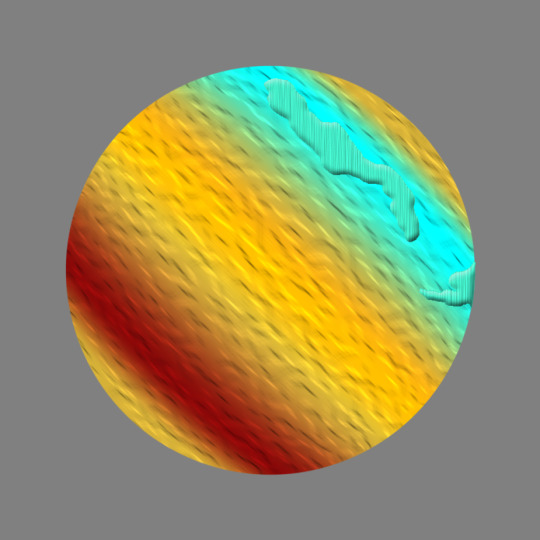
Planet type: Rocky, with a lethally toxic atmosphere
Sky color: Gold, with bands of blood red, cyan and amber
Moons: 18 (12 large moons)
Planetary rings: None
Size: 1.032 x 1022 tonnes (1.72x the size of Earth)
Radius: 6,809 miles (10,958 km)
Gravity: 0.84x Earth’s gravity
Axial tilt: 72.7°
Temperature range: 60°C (140°F) to 102°C (215.6°F)
Average surface temperature: 81°C (177.8°F)
Water prevalence: 21% (all surface water)
Earth life: Unsuitable for Earth-based life without additional support
Length of day: 26 hours
Length of year: 130 Earth days
Seasonal variations: Extreme (temperatures vary intensely across the year, with a large difference between the hottest and coldest seasons)
Namesake: Ambika (or Ambika Devi), the yakshini ("dedicated attendant deity") of the 22nd Tirthankhara, Neminatha, in Jainism
Fun fact: Ambika is the only planet other than Earth to have a substantial amount of surface water
Shiva
(SHIH-vah)
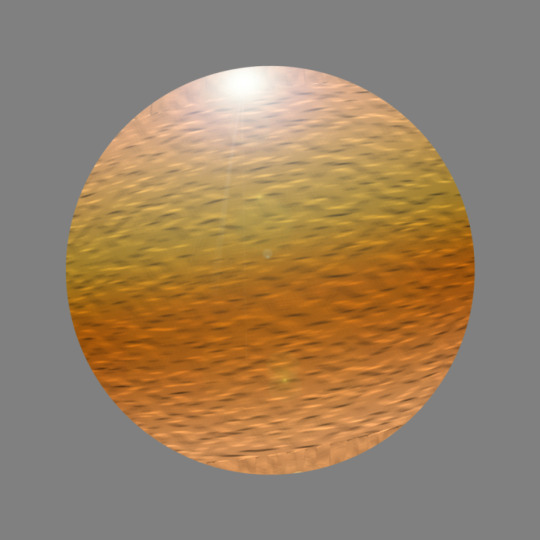
Planet type: Desert
Sky color: Caramel, with bands of drab orange and brown
Moons: None
Planetary rings: None
Size: 8.46 x 1021 tonnes (1.41x the size of Earth)
Radius: 5,982 miles (8,983 km)
Gravity: 0.81x Earth’s gravity
Axial tilt: 5.4°
Temperature range: 26°C (78.8°F) to 170°C (338°F)
Average surface temperature: 98°C (208.4°F)
Water prevalence: 11% (1% surface water, 10% subterranean)
Earth life: Difficult, but habitable for Earth-based life
Length of day: 36 hours
Length of year: 464 Earth days
Seasonal variations: Distinct (multiple distinct seasons with notable temperature differences during the year)
Namesake: Shiva (aka Mahadeva or Hara, among other names), god of destruction & time, and one of the primordial deities in Hinduism.
Fun fact: Shiva's north pole, through multiple heat-related phenomena, has glass instead of sand on the ground, thus making it extremely reflective
Izanagi
(EE-zah-NAH-gee)
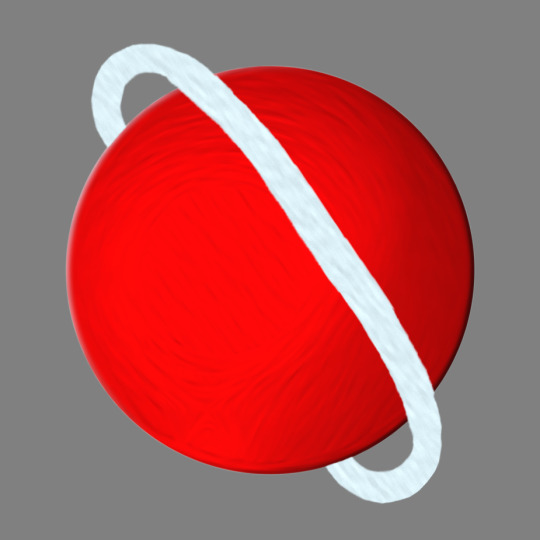
Planet type: Gas giant
Sky color: Red
Moons: 70 (17 large moons)
Planetary rings: 1 (large, dense, made primarily of ice)
Size: 4.2 x 1022 tonnes (7x the size of Earth)
Radius: 27,711 miles (44,597 km)
Gravity: 1.47x Earth’s gravity
Axial tilt: 33.4°
Temperature range: 221°C (429.8°F) to 852°C (1,565.6°F)
Average surface temperature: 537°C (998.6°F)
Water prevalence: None
Earth life: Impossible for Earth-based life to exist (no solid surface, extreme temperatures)
Length of day: 323 Earth days
Length of year: 24 Earth years
Seasonal variations: Distinct (multiple distinct seasons with notable temperature differences during the year)
Namesake: Izanagi, or Izanaki, the primordial god of creation and life in Japanese mythology
Fun fact: Izanagi is the largest planet in the Solar System, and has the largest ring system
Mahakali
(MAH-ha-KAH-lee)
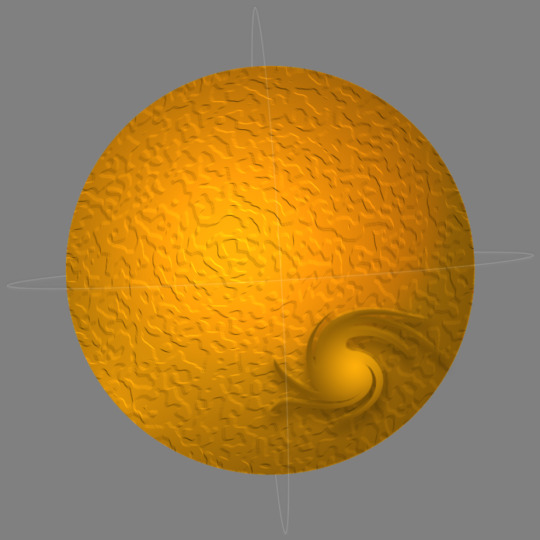
Planet type: Gas giant
Sky color: Smooth orange
Moons: 88 (1 large moon (Mizuchi))
Planetary rings: 2 (narrow, near-invisible, made primarily of gas)
Size: 3 x 1022 tonnes (5x the size of Earth)
Radius: 19,794 miles (31,855 km)
Gravity: 0.86x Earth’s gravity
Axial tilt: 3.3°
Temperature range: 8°C (46.4°F) to 515°C (959°F)
Average surface temperature: 262°C (503.6°F)
Water prevalence: None
Earth life: Impossible for Earth-based life to exist (no solid surface, extreme temperatures)
Length of day: 12 hours
Length of year: 31 Earth years
Seasonal variations: None (the planet’s circular orbit means temperature variations are caused by the day/night cycle only)
Namesake: Mahakali, the goddess of time and death in Shaktism, a major denomination of Hinduism
Fun fact: Mahakali's cyclonic storm in its southern hemisphere is the largest observed such storm in the Solar System
Haneunim
(ha-NU-nim)
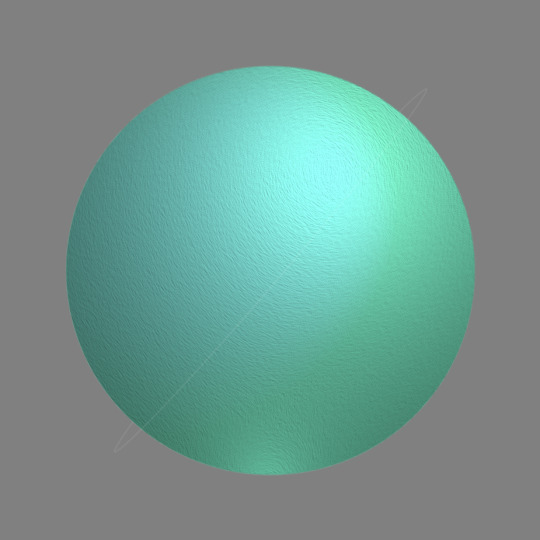
Planet type: Ice giant
Sky color: Aquamarine
Moons: 113 (19 large moons)
Planetary rings: 1 (narrow, near-invisible, made primarily of ice)
Size: 2.262 x 1022 tonnes (3.77x the size of Earth)
Radius: 14,925 miles (24,019 km)
Gravity: 0.83x Earth’s gravity
Axial tilt: 49.3°
Temperature range: -185°C (-301°F) to 306°C (582.8°F)
Average surface temperature: 61°C (141.8°F)
Water prevalence: 1% (supercritical water)
Earth life: Impossible for Earth-based life to exist (no solid surface, high pressures, extreme temperatures)
Length of day: 296 Earth days
Length of year: 85 Earth years
Seasonal variations: Extreme (temperatures vary intensely across the year, with a large difference between the hottest and coldest seasons)
Namesake: Haneunim, or Hanunim, god of the sky in Korean mythology
Fun fact: Haneunim has the most moons of any one planet in the Solar System
Kianda
(kee-YAHN-dah)
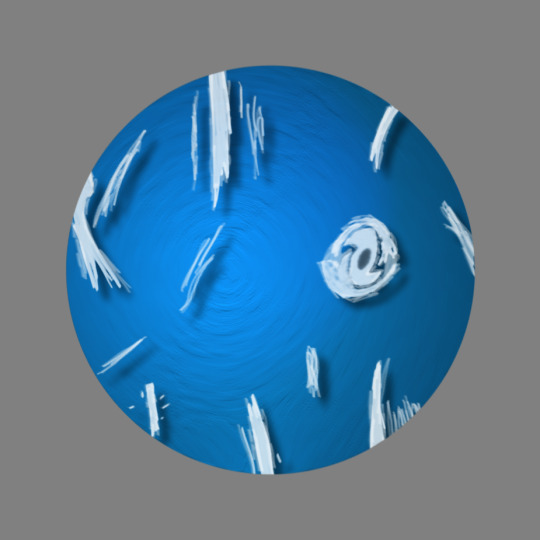
Planet type: Ice giant
Sky color: Intense blue
Moons: 92 (12 large moons)
Planetary rings: None
Size: 2.85 x 1022 tonnes (4.75x the size of Earth)
Radius: 18,804 miles (30,262 km)
Gravity: 1.38x Earth’s gravity
Axial tilt: 45.8°
Temperature range: -154°C (-245.2°F) to 75°C (167°F)
Average surface temperature: -40°C (-40°F)
Water prevalence: 10% (supercritical water)
Earth life: Impossible for Earth-based life to exist (no solid surface, high pressures, extreme temperatures)
Length of day: 44 hours
Length of year: 88 Earth years
Seasonal variations: Extreme (temperatures vary intensely across the year, with a large difference between the hottest and coldest seasons)
Namesake: Kianda, or Dandalunda, goddess of the sea, the waters, and a protector of fishermen in traditional Angolan culture
Fun fact: Kianda's low-altitude clouds cast shadows on the cloud deck
Ereshkigal
(ur-RESH-keh-gal)
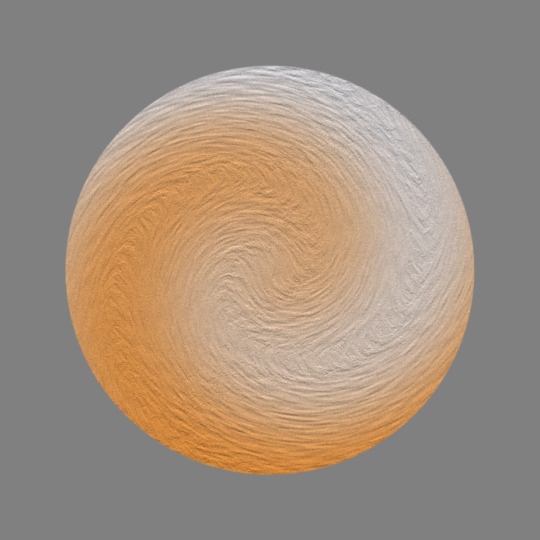
Planet type: Frozen
Sky color: Swirling bronze and slate
Moons: 1 (Wollunqua)
Planetary rings: None
Size: 2.58 x 1021 tonnes (0.43x the size of Earth)
Radius: 1,702 miles (2,740 km)
Gravity: 1.18x Earth’s gravity
Axial tilt: 35.1°
Temperature range: -196°C (-320.8°F) to -96°C (-140.8°F)
Average surface temperature: -146°C (-230.8°F)
Water prevalence: 9% (deep subterranean liquid water)
Earth life: Unsuitable for Earth-based life without additional support
Length of day: 508 Earth days
Length of year: 205 Earth years
Seasonal variations: Slight (temperatures vary only slightly based on the position of the planet over the year)
Namesake: Ereshkigal, or Irkalla, goddess and queen of the underworld and the dead in Sumerian mythology
Fun fact: Ereshkigal was initially classified as a dwarf planet upon its discovery, but was eventually reclassified as a planet years later after further research
11 notes
·
View notes
Text
Battletech: Mira planetary report
Mira Planetary Report 3025 year
Recharging station: none
ComStar Facility Class: B
Population: 3 million
Percentage and level of native life: 15% mammal
Note: These refer to land life, like most colonized worlds, native life is replaced with Terran species, nobody bothers with ocean life, unless is relevant somehow. In Mira case, algae are vital to the ecosystem but this means commercial fishing is not practicable as it clogs nets.
Star System Data
Star Type: F6III (subgiant)
Position in System: 4th planet (Mira IV)
Distance from Star: Approximately 3.16 AU (within the habitable zone of an F6III star)
Travel Time to Jump Point: 10 days at 1G acceleration
Mira orbits an F6III subgiant star, larger and brighter than Sol (a G2V star), which extends the habitable zone farther out and increases dropship travel time to the jump point compared to Terra’s 6-8 days. The 10-day journey reflects the standard BattleTech transit model: dropships accelerate at 1G for half the voyage, perform a turnover, and decelerate at 1G to arrive at zero velocity.
Planetary Data
Diameter: 12,000 km (comparable to Terra)
Gravity: 0.9g
Atmosphere: Standard, breathable; slightly thinner than Terra’s but enriched with oxygen due to abundant oceanic algae
Hydrosphere: 85% water coverage
Natural Satellites: Two small moons
Population: 2.8 million (as of 2975)
Government: Part of the Capellan Confederation (liberated by the 1st St. Ives Lancers in 2975)
Mira, the fourth planet in its system, orbits an F6III subgiant star at approximately 3.16 AU, placing it within the habitable zone. Its diameter and gravity (0.9g) are close to Terra’s, making it comfortable for human habitation. The atmosphere, though thinner than Terra’s, supports life with a higher oxygen content due to widespread algal blooms in its vast oceans, which cover 85% of the surface. Two small moons influence tidal patterns, while a strong magnetosphere shields the planet from stellar radiation. In 2975, Mira was liberated by the 1st St. Ives Lancers, integrating it into the Capellan Confederation.
Year Length: 1300 Earth days (3.55 years), with ~325-day seasons, orbiting at ~3.16 AU around a ~2.5 solar mass F6III star.
Axial Tilt: ~23.5°, supporting southern Russia/Crimea-like seasonal cycles.
Latitudinal Climate Gradient:
Temperate Zones (20°–50°N/S): Southern Russia/Crimea-like (5–25°C, 400–800 mm rainfall), with coastal resorts and agriculture.
Mountainous Regions: Caucasus-like, cooler (0–15°C), with snowfall.
Equatorial Zones (0°–20°N/S): Warm, humid (25–35°C, 800–1200 mm rainfall), supporting algal blooms.
Astronomical Quirk: Strong magnetosphere shields against F6III radiation; two moons stabilize orbit and tilt.
Oceanic Nature: 85% water coverage drives albedo, cloud cover, and precipitation, moderating climate for habitability.
Stellar Characteristics and Perception Mira’s parent star, an F6III subgiant, differs significantly from Sol (a G2V star) in ways that shape the planet’s environment and how its sunlight is perceived:
Luminosity: The F6III star is far more luminous than Sol, emitting approximately 20–30 times more light. This increased output pushes the habitable zone farther out, allowing Mira to sustain life at 3.16 AU despite the star’s intensity.
Apparent Size: From Mira’s surface, the star appears larger in the sky than Sol does from Terra. Given the F6III star’s larger physical size and the adjusted distance of the habitable zone, its apparent diameter might be 1.5–2 times that of Sol as seen from Earth, creating a striking visual presence.
Light Temperature: With a surface temperature of 6,500–7,000 K (compared to Sol’s 5,772 K), the star’s light is bluer and more intense. This higher color temperature results in a harsher daylight compared to Terra’s warmer, yellower sunlight. The bluish tint could require adaptations for human comfort—such as tinted visors or specialized architecture—and might influence plant photosynthesis, favoring species adapted to bluer wavelengths.
The sunlight on Mira is indeed harsher due to its intensity and blue-shift, contrasting with Sol’s gentler glow, altering the planet’s aesthetic and environmental dynamics.
Impact of Oceans and Cloud Cover Mira’s extensive oceans, covering 85% of its surface, interact with the star’s intense sunlight to moderate its effects. The brighter, more energetic light drives higher rates of evaporation compared to Terra (which has 71% water coverage), leading to increased cloud formation. This thick cloud cover acts as a natural filter, reflecting a portion of the star’s radiation back into space and diffusing the remaining light. As a result, the harshness of the sunlight is lessened, softening its impact on the surface and contributing to a more temperate climate. This interplay between intense stellar output and planetary water creates a balanced, livable environment despite the star’s power.
Geography
Mira is predominantly a waterworld, with oceans covering 85% of its surface. Its limited landmass consists of archipelagos and small continents, many featuring mountainous terrain. These islands, often volcanic in origin, exhibit active tectonics, akin to Terra’s Oceania region. Volcanic activity is moderate rather than absent, as waterworlds with fragmented landmasses typically experience tectonic movement due to thinner crusts and mantle convection—though less intense than on continents with massive tectonic plates. The scarce flat land is reserved for agriculture and settlements, while the mountains yield coal and metallic ores, though not in quantities sufficient for major industry. Offshore platforms exploit hydrocarbons (oil and gas) from the ocean floor, as the mountainous land lacks significant sedimentary deposits typical of flat terrains where fossil fuels accumulate.
Climate
Mira’s climate is moderated by its extensive oceans, which act as a heat sink to prevent extreme temperature swings. The temperate zones on larger landmasses resemble southern Russia—warm summers and cool winters—while coastal areas and islands enjoy a milder, Crimea-like climate, ideal for resorts. The mountains, similar to the Caucasus, experience cooler temperatures and seasonal snowfall. Despite orbiting a hotter F6III star, Mira’s water coverage balances the climate, making it more pleasant than Tikonov (a harsh world orbiting a G8V star). The temperate zones align with the Kuban and Crimea, offering a respite for Tikonov nobles accustomed to continental rigors.
History
Mira was settled in the early 22nd century by Russian colonists from nearby Tikonov, who named it “Mira”—Russian for “world” and “peace”—reflecting its tranquil appeal. Initially an independent colony, it was annexed by the Marlette Association by 2306. In 2309, the Tikonov Grand Union, under General Diana Chinn, captured Mira after a 23-week campaign, integrating it into their domain. Its proximity to Tikonov (a single jump away) and pleasant environment made it a resort planet, with its continent parceled out into luxury estates for Tikonov nobility.
During the Succession Wars, Mira’s strategic location transformed it into a contested frontier. In 2829, the Bloody Suns mercenary unit invaded, expecting an easy victory over the Third Chesterton Cavalry. The defenders resorted to chemical weapons, prompting Duke Hasek of the Federated Suns to order a nuclear strike, followed by the Eighth Crucis Lancers’ ruthless mop-up. This brutal conflict left a lasting mark. Mira changed hands repeatedly between the Capellan Confederation and Federated Suns, serving as a staging base for attacks on Tikonov. In 2975, it was liberated by the 1st St. Ives Lancers, integrating it into the Capellan Confederation.
Economy
Mira’s economy is modest, shaped by its sparse population and limited resources. Its textile industry, producing high-quality fabrics, has earned it the nickname “clothiers to the galaxy,” with exports reaching across the Inner Sphere.
Sea mining of hydrocarbons via offshore platforms in the shallow waters sustains some light and heavy industry, compensating for the lack of easily extractable mineral resources and fertile arable land, which has prevented major industrial or agricultural development.
Notable Features
Molotosky Water Purification Process: A Mira innovation, widely adopted for its efficiency in water purification.
Luxury Estates: Historic resorts of Tikonov nobles, blending Russian and Asian architectural styles, now cultural landmarks.
Textile Industry: Renowned for craftsmanship, a cornerstone of Mira’s identity.
Cultural Heritage: Reflects its Tikonov settlers’ Eurasian roots, evident in architecture and traditions.
Military Significance
Mira’s proximity to Tikonov makes it a strategic linchpin. Its ports and spaceports support military logistics, and its history as a staging base underscores its value in conflicts between the Capellan Confederation and Federated Suns.
4 notes
·
View notes
Note
Mercury is the closest planet to the Sun and due to its proximity it is not easily seen except during twilight. For every two orbits of the Sun, Mercury completes three rotations about its axis and up until 1965 it was thought that the same side of Mercury constantly faced the Sun. Thirteen times a century Mercury can be observed from the Earth passing across the face of the Sun in an event called a transit. Mercury is the smallest planet. A year on Mercury takes 88 Earth days. Venus is the second planet from the Sun and is the second largest terrestrial planet. Venus is sometimes referred to as the Earth’s sister planet due to their similar size and mass. Venus is named after the Roman goddess of love and beauty. The surface temperature on Venus can reach 471 °C. A year on Venus takes 225 Earth days. Earth is the third planet from the Sun and is the largest of the terrestrial planets. The Earth is the only planet in our solar system not to be named after a Greek or Roman deity. The Earth was formed approximately 4.54 billion years ago and is the only known planet to support life. Earth is the only planet not named after a god. The Earth’s rotation is gradually slowing. Mars is the fourth planet from the Sun and is the second smallest planet in the solar system. Named after the Roman god of war, Mars is also often described as the “Red Planet” due to its reddish appearance. Mars is a terrestrial planet with a thin atmosphere composed primarily of carbon dioxide. Mars takes its name from the Roman god of war. Sunsets on Mars are blue. Jupiter is the largest planet in the solar system and is the fifth planet out from the Sun. It is two and a half times more massive than all the other planets in the solar system combined. It is made primarily of gases and is therefore known as a “gas giant”. The ancient Babylonians were the first to record their sightings of Jupiter. The Great Red Spot is a huge storm on Jupiter. Best known for its fabulous ring system, Saturn is the sixth planet from the Sun and the second largest in our solar system. Like Jupiter, Saturn is a gas giant and is composed of similar gasses including hydrogen, helium and methane. Saturn has oval-shaped storms similar to Jupiter's. Saturn has 150 moons and smaller moonlets. Uranus is the seventh planet from the Sun. It’s not visible to the naked eye, and became the first planet discovered with the use of a telescope. Uranus is tipped over on its side with an axial tilt of 98 degrees. It is often described as “rolling around the Sun on its side.” Uranus was officially discovered by Sir William Herschel in 1781. Uranus is often referred to as an “ice giant” planet. Neptune is the eighth planet from the Sun, making it the most distant in the solar system. This gas giant may have formed much closer to the Sun in the early solar system history before migrating out to its current position. Neptune is named after the Roman god of the sea. Only one spacecraft has flown by Neptune.
"Tell me something I don't know. Which is impossible, because I'm the biggest astronomy nerd in South Park. Source: Tweek."
#ask craig tucker#south park#southpark#ask blog#south park craig#craig tucker#sp craig#astronomy#ask that isn't a question#creek#south park creek#sp creek
16 notes
·
View notes
Text
No. 5 - D2, Shrine of the Kuo-Toa (August 1978)
Author(s): Gary Gygax Artist(s): David C. Sutherland III (Cover), David A. Trampier Level range: Average of 10, preferrably party size 7+ players Theme: Underground exploration Major re-releases: D1-2 Descent into the Depths of the Earth, GDQ1-7 Queen of the Spiders
I'm almost speechless. This is the most 1e module cover to ever have 1e'd. It is perfection. The way the combat is perfectly perpendicular to the step pyramid. The bondage gear fishman who has a complete fishhead so you 100% understand he's a fishman. Lobster mommy saluting the troops. It's just….it's what dreams are made of.
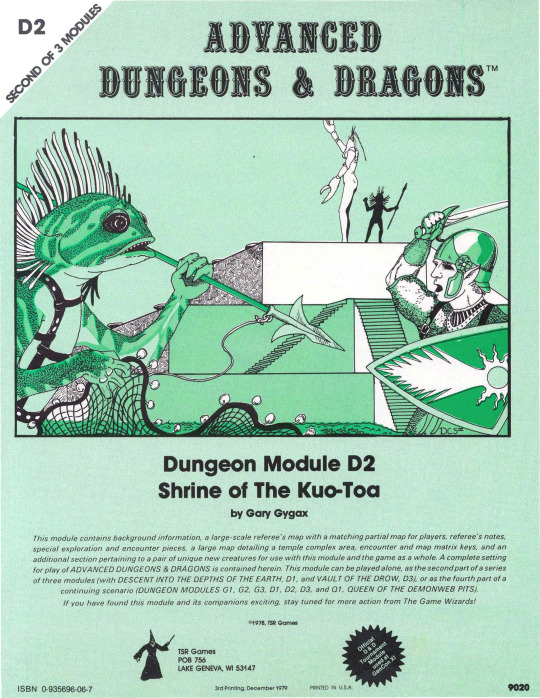
So I'm already in love with this module, deeply and irrationally in love with it, before breaking the cover. If you're BORING you might prefer the later Jim Roslof cover art that's got lame things like technical proficiency. Ugh. The shit I have to put up with.
Anyway, there's a lot to talk about with D2! It's a lot of firsts for an official TSR product, and critically it's a lot of GOOD firsts.
It's the debut of the Kuo-Toa, one of the most fun groups of people in D&D! It's the first module that doesn't presume the enemy will be inherently aggressive! It's got a lot of negotiation and learning! The only good type of gnomes debuts with the Svirfneblin! This model of "alien settlement where you are not instantly attacked but you gotta learn the social rules and play along" is just the best. This will be done again in U2 and I adore U2. Yeah it's how it feels to go to a different country, especially one that doesn't speak your language, and just have everything be a little "off" compared to what you're used to, but. To me, it will always be The Autistic Experience. How well and quickly can you learn these bizarro social rules you can't intuit and what's the fewest number of whacks to the head it takes to get there? How long can you swallow your complaints when you see stuff that's obviously cruel, but the people around you don't perceive it as cruel anymore because it's The Way Things Are and they will actively defend the cruelty of it?
Ok, ok, back to your regularly scheduled program.
Gary starts off this week's festivities by telling you to be toxic to your players:

Sometimes it feels like there's three Garys in a trenchcoat and they take turns writing the modules.
So D2 starts in the cave at the immediate end of D1 and, let me derail already by saying that I really, really hate old-style hex maps. I cannot follow them -- I don't mean I don't understand how you're supposed to follow them, I mean it's nearly impossible for me to follow the diagonal to the destination. Your coordinate here is R20. Here is your map. Follow the 20 axis diagonally upward and rightward until you intersect with the R row. Can you do it?
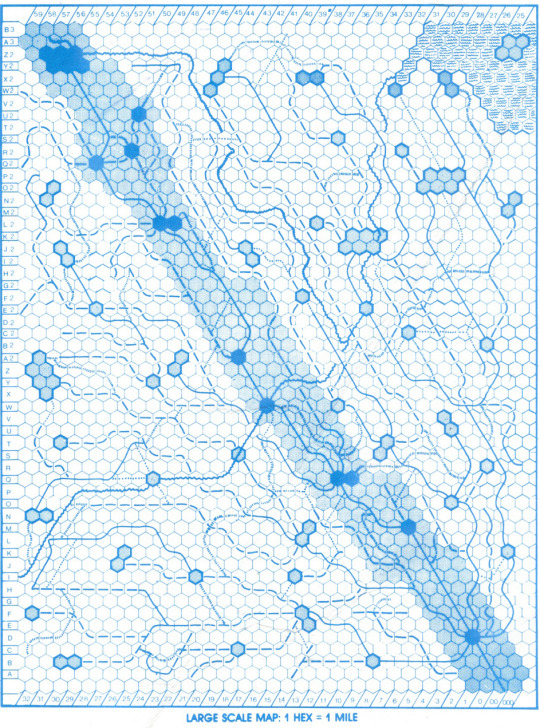
Personally, I can't. My eye cannot follow that straight line, it will get lost in the mix of blank identical hexes and occasional interest objects. I sat here trying to follow it for 5 minutes and I couldn't do it. I need a straightedge to do it. The correct answer is that if you follow the light blue area from the bottom right towards the top left, it's the hex up and left of the fourth fully black hex you run into -- the leftmost of the two touching black hexes. I tested this against a few guinea pigs and no-one else could mange it either. Later we will admit defeat and that this axial coordinate system for hexmaps is, uh, really fucking bad, and replace it with offset coordinates (or even better, double coordinates) which more closely resemble normal cartesian coordinates, and by extension are not Eye Strain Central. They have the downside of different eyestrain (tiny font) and that you literally cannot fit as many hexes on the page, but the point of a graphic is to communicate information and the axial coordinate hexmap is bad at that unless you're playing on a huge table with like, two DM screens.
Yes this rant should've gone in D1, mea culpa. In my defense, D1-2 is, basically one module in two parts, they're not really separable.
Here's the coordinate lined out for you, since I imagine many of you have the same issue:

So, now that I have a headache trying to read, we can get to the actual text of the adventure again. Now keep in mind that max movement rate is 1 hex per 1 inch of movement for the slowest member of the party (so like, your guy wearing platemail has 60ft of movement, 10ft to the inch: 6 hexes per day). This means you could hypothetically arrive at the final location as quickly as 22/6=4 days of gameplay, 3 if no one including hirelings wore plate. That is, if you beelined to D2 by sheer luck, never got lost, never got distracted, never got slowed down, never had to take a rest day. Which is good because the food in The Depths seems questionable.
The first segment of the adventure is mostly reprinted from D1 -- random tables and maps and the like. We do get the addition of everyone's favorite early DND trope: a slavery table! And also happilly we get some goopy guys to move your eyes away from that shit:
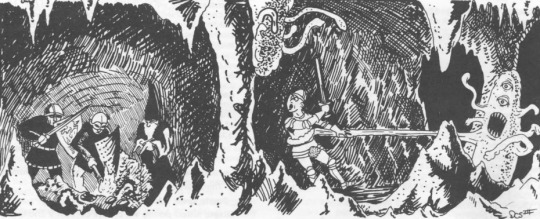
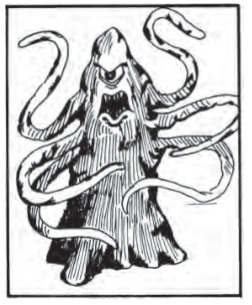

Which, is a lot more my speed. More goopy guys. It's a roper, actually, although I frankly didn't recognize it. It looks more like the monster from Dexter's Lab? Apparently Ropers have changed a lot in the last 50 years.
So it's all random tables teasing that we're going to end up arriving at a shrine soon. There is a special entry in the back for the new Kuo-Toa and Svirfneblin, and oddly the Svirfneblin don't get a header? We don't learn much. We know that they're natural elemental summoners, that they're "natural fighters", and that they live at some unstated cave somewhere. They like their stun gas darts, they "communicate with racial empathy" (which I guess means body language?) outside their own domains, deep gnomish at home, and underworld cant when they're trading, plus earth elemental-ese. So they learn a lot as kids. They love them some traps, too, basically they're the gnomish Rambos and I love them for it.
Meanwhile, our titular Kuo-Toa get a pretty standard write-up. Driven underground, human sacrifice, raiders, like their war parties. Their priests like their mancatchers, which are based on lobster claws, they spawn in pools, they can spontaneously generate lightning by holding hands (???), are too slippery to grab, can see both infrared AND ultraviolent, can see you moving through basically any magical means, immune to poison, paralysis, charming, sleep, and are resistant to magic missile and lightning. This is, very very weird. They are wildly powerful compared to their later versions, and the only upshot is that they're readily blinded by light spells. Apparently they go insane with such regularity that they have a dedicated social role to controlling or killing the crazed? Yeah these people are a piece of work.
We get a little setpiece moment here where, essentially, there's a rogue kuo-toa who will offer you a trip across the river for 10g. He only speaks kuo-toa and he'll sicc his giant fish on you if you don't say yes fast enough. In fact, a lot of ink is spilled on this little moment, which in all likelihood will be a brief conversation and some passing of money.
Before you get into the shrine proper, some svirfneblin offer to help you in the shrine if you go halfsies on treasure (with almost that exact wordchoice).
Finally, we end up in the shrine proper, which is keyed so let us enter Keyed Mode ™️
The whole area is lit by glow-in-the-dark lichens, which is a spooky way to reveal the lobster lady idol up on the pyramid
While the party can choose to politely integrate into the crowd and play along, there's lots of little things to harass them into nonconformity. Leeches, horrifying offerings, offerings of increasing amount, having to correctly pronounce nonsense names (Blibdoolpoolp????????), holding a live lobster, it's a good bit.
You can, in fact, visit the goddess, who will give you a boon (if you give an offering) or a geas (if you don't), which also grants you kuo-toa speech and also a mark of loyalty, which is neat. You can also encounter her if you fuck around in the prince's treasure room, so the odds of meeting her are actually pretty good! Note that this is pre-"Kuo-Toa believe their gods into existence" so in this case they are worshipping a (hypothetically) permanent, naturally-occurring deity. Being that this is 1e and she is a she, she is Extremely Naked. She is later called The Mother of Lusts, which is one hell of a title.
If you fail to get the priest-prince when you meet him, he actually has a pretty rock-solid escape plan and will come back with an army. So, probably whack him if possible. I really like when antagonists have the sense to piss off and come back armed, rather than pridefully stand and die. You get the sense that Va-Guulgh is priest-prince because he plans contingencies like this, whereas other Kuo-Toa simply vibe. That being said, the Kuo-Toa are apparently not equipped for a search, so it's pretty easy to ditch them.

Sigh.
We do not have a dramatic declaration of THE END anymore, which is a terrible shame. We instead get a more reasonable "This is the end of the section."
The magic of D2 is more in the play and less in the overview. Like, look at this map:

This is a pretty naturalistic map. This is just how you'd arrange a major structure, rather than the kind of nonsense layouts you see in a lot of early dungeons. I don't put much stock in "Gygaxian Naturalism", I think Gary presented pretty intensely game-y spaces and they only seemed naturalistic by 1970s published product standards, but nonetheless he was paving the way compared to some of the silliness you got in pre-G1 modules. This map is good, I think, in that it becomes super extremely obvious to the players from the moment you enter that they extremely do not want to provoke a full alarm -- this is a shrine where you want to kill as few Kuo-Toa as you can, and as many of those as you can behind closed-doors -- it's time to straight up bail if the alarm goes off because you are not beating the hundreds of guys here if you you provoke them up front.
We end with some rust monster art, my favorite monster that I never use because I think I'd get shanked if I did. See you next time in D3!

16 notes
·
View notes
Text
spoilers for future insomniac-isotope posts but i put together a little clock dial based on time of day and then i was like "hmm it would be neat to make the length of the day vary based on season" and then i must have blacked out or something b/c now i'm looking at the wikipedia article for saros and trying to determine how axial wobble factors into all of this
4 notes
·
View notes
Text
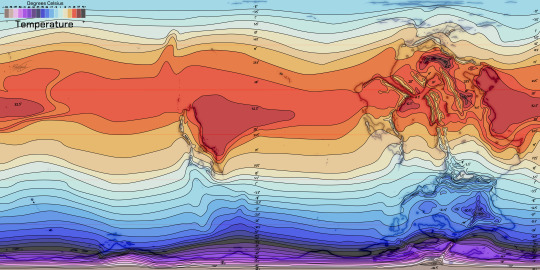
I present to you, the surface temperature map of Jom'Gol during Northern Hemisphere Summer. This map took me DAYS and dozens of hours of work... and now i have to repeat it for winter too....
Legend is in the top left corner again, but every band of color is exactly 4.5 degrees Celsius. Some interesting spots on this map include the northern hemisphere's hottest average day temp of 46 degrees C (115 F), and the southern hemisphere's coldest average day temp of -107 degrees C (-160 F).
Due to the absolute size of the planet AND the continents, the uneven heating of the surface, biotic carbon cycles, and most importantly the fact that the axial tilt is 40 degrees, the temperature difference between regions can be quite extreme.
#art#digital art#artists on tumblr#worldbuilding#speculative biology#speculative evolution#spec bio#spec evo#jomgol#mapmaking#maps#digital painting#speculative worldbuilding#speculative botany#speculative zoology
14 notes
·
View notes
Text

Astronomers discover ultra-dense 'super-Earth' with outer companion offering clues about its formation
An international team led by researchers in Japan and Europe has discovered a new multi-planet system around a sun-like star, including an ultra-short period planet with one of the highest densities ever measured. The findings, published in Scientific Reports on 8 November, shed new light on the formation and evolution of planets in extreme environments.
The newly discovered system, named K2-360, is located approximately 750 light-years from Earth. It consists of two planets orbiting a star similar to our sun:
K2-360 b: An ultra-short period "super-Earth" (rocky planet larger than Earth but smaller than Neptune) about 1.6 times the size of Earth, orbiting its star every 21 hours. With a mass 7.7 times that of Earth, it is the densest well-characterized planet of its kind discovered to date.
K2-360 c: A larger outer planet at least 15 times more massive than Earth, orbiting every 9.8 days. This planet does not transit its star, so its exact size is unknown.
"K2-360 b is truly remarkable—it's as dense as lead, packing nearly 8 Earth masses into a ball only slightly larger than our planet," says John Livingston, lead author of the study from the Astrobiology Center in Tokyo, Japan. "This makes it the densest known planet among the class of 'ultra-short period' planets [with precise parameters], which orbit their stars in less than a day."
The discovery was made possible by NASA's K2 mission, which first detected the inner planet transiting in front of its star in 2016. Follow-up observations with ground-based telescopes, including the HARPS and HARPS-N spectrographs, confirmed the planet's nature and revealed the presence of the outer companion.
The extreme density of K2-360 b suggests it may be the stripped core of a once-larger planet, having lost its outer layers due to intense radiation from its nearby host star.
"This planet gives us a glimpse into the possible fate of some close-in worlds, where only the dense, rocky cores remain after billions of years of evolution," explains co-author Davide Gandolfi from the University of Turin.
The outer planet, K2-360 c, adds another layer of intrigue to the system. While not transiting its star, its gravitational pull on the host star allowed researchers to measure its minimum mass. Computer simulations suggest it may have played a crucial role in the formation and evolution of the system.
While many close-in planets are thought to have migrated inward through interactions with their natal gas disk, K2-360 b likely followed a different path.
"Our dynamical models indicate that K2-360 c could have pushed the inner planet into its current tight orbit through a process called high-eccentricity migration," says co-author Alessandro Trani from the Niels Bohr Institute.
"This involves gravitational interactions that first make the inner planet's orbit very elliptical, before tidal forces gradually circularize it close to the star. Alternatively, tidal circularization could have been induced by the spin-axial tilt of the planet."
The team's analysis suggests that K2-360 b has an iron-rich, rocky composition more similar to Earth than Mercury. Using models based on the observed chemical abundances of the host star, the researchers estimate that K2-360 b likely has a large iron core making up about 48% of its mass. This places it closer to being a "super-Earth" than a "super-Mercury," despite its extreme density.
"Our interior structure models indicate that K2-360 b probably has a substantial iron core surrounded by a rocky mantle," explains co-author Mahesh Herath, a Ph.D. candidate at McGill University. "Its surface may be covered in magma due to the intense heat it receives from its star. Understanding planets like this helps us piece together how terrestrial planets form and evolve under different conditions throughout the galaxy."
The discovery of the K2-360 system provides valuable insights into planetary system architectures and the processes that shape them. Ultra-short period planets like K2-360 b are relatively rare, and finding one with a massive outer companion helps constrain theories about their formation.
"K2-360 is an excellent laboratory for studying how planets form and evolve in extreme environments," concludes Livingston.
IMAGE: Artist's conception of the K2-360 system, showing the ultra-dense super-Earth K2-360 b (red) in its extremely close orbit around its sun-like star, with the more distant companion K2-360 c (blue) in the background. The scorching temperatures on K2-360 b, which completes an orbit in just 21 hours, likely result in a molten or partially molten surface. Credit: Astrobiology Center
2 notes
·
View notes
Photo

Quran
The Quran (also written Qur’an or Koran), revealed in the 7th century, is the sacred book of Islam, following in the tradition of the Abrahamic faiths, with the Torah as the sacred book of Judaism and the New Testament as the sacred book of Christianity.
Tarif Khalidi, a Palestinian historian who was formerly Sir Thomas Adams’ Professor of Arabic at Cambridge University and currently holds the Shaykh Zayed Chair for Arabic and Islamic Studies at the American University of Beirut says:
The Qur’an is the axial text of a major religious civilization and a major world language. For both Islamic civilization and the Arabic language the Qur’an consecrates a finality of authority granted to few texts in history.
(Khalidi, ix)
The Revelation
For the Muslim faithful, the Qur’an contains the verses of the word of God as revealed in the Arabic language to the Prophet Muhammad (also written Muhammed, c. 570 – 632) over the course of 22 years from approximately 610 to 632. The word qur'an derives from the Arabic verb qara'a meaning to read or recite. The very first Sura (chapter) revealed to the Prophet Muhammad while he was on a spiritual retreat in a cave was:
In the name of God,
Merciful to all,
Compassionate to each!
Recite, in the name of your Lord!
He Who Created!
He created man from a blood clot.
Recite! Your Lord is most bountiful.
He taught with the pen.
He taught man what he knew not.
Sura 96 The Blood Clot, Aya (Verses) 1-5 (Khalidi trans, 515)
Key texts within the tradition of Islamic heritage, the sayings, hadith (reports), and stories that form the sunna, a record of the Prophet’s life, recount the occasion of the revelation of the Qur’an to the Prophet on the Night of Power, Laylat al-Qadr – generally attributed to the 23rd or 27th night of the month of Ramadan – sacred to Muslims. In the year 610, at 40 years of age, Muhammad sat in meditation in the cave of Mount Hira and was approached by the angel Gabriel who ordered him: Recite! Muhammad was unable to speak until the third time he was commanded and then recited the sura (chapter) 96 above. Unsettled by this encounter, Muhammad set out in search of his wife Khadija who wrapped him in a cloak to stop him from shivering.
However, he then received the revelation of Surah 74, telling him to stand up and preach his message:
In the name of God,
Merciful to all,
Compassionate to each!
You who are enfolded in your garments:
Stand up and warn!
Magnify your Lord!
Purify your garments!
And abandon impurity!
And give not hoping to get more! Be steadfast to your Lord!
Sura (Chapter) 74 Enfolded, Aya (Verses) 1-7 (Khalidi trans, 486)
Continue reading...
23 notes
·
View notes
Text
VIK 10.08.3343 IE NH // TUE 12.05.2023 CE GD
It appears I was wrong on *several* levels regarding the nature of my innerworld, as well as my kintype.[1]
After much reflection, our innerworld’s genres appear to be (1) mythic historical iyashikei (albeit with Brothers Grimmesque folkloric / psychological horror elements), and (2) Arcadian Filianic media.
Similar works include “Spice and Wolf” by Isuna Hasekura, “Violet Evergarden” by Kana Akatsuki, “Little Goody Two Shoes” by AstralShift & Square Enix — *MAJOR* vibes with LGTS, by the way — and *especially* “Aristasia” by The Aristasia Community.
I (Yashi) appear to be a vixen spirit (one of the local minor geniae, to use a Filianic term) very similar to Holo from “Spice and Wolf”. We (the Orchards) are ALL spirits, as far as we know (there’s five of us). [2]
Rhiannë (aka Kyria, our godshard of Dea Filia) is a horsegirl (like those in “Uma Musume Pretty Derby” by Cygames) as opposed to a centaur, because… that’s just easier to visualize, I guess. Yasumi (if that’s still her name) is a local minor folk janya of healing. Sophie’s an attendant of Sai Candrë, which is a mythological pun — she’s an insomniac rabbitgirl, and in Japanese folklore, the moon (Sai Candrë’s sphere)’s associated with rabbits. This would also explain why Sophie looks so tired all the time: because her job requires her to work at night, yet she (Sophie) still interacts with the rest of the Orchards during daylight hours! Blueberry might be of the shiani (Filianic fae), but I’m still not quite sure. I’ll have to make it a point to ask her sooner or later.
Roughly 99% of other maids only see us Orchards as everyday Axials (ie “typical” intemorphs, of which, in this particular innerworld, there’s a bare minimum of *seven* feminine types — each based upon one or more of the myriad janyatic principles). [3] That said, this kinda-sorta works similar to Amaterasu’s divine markings in “Ōkami” by Clover Studio & Capcom — we (the Orchards) can see one another’s true forms, but most maids who aren’t spirit-beings or spiritually attuned can’t see our animal ears, tails, wings, etc.
The main area of the innerworld is Saresgrove. In older English, “sare” means “withered, rotten, dry, melancholy, etc”. Thus, “Saresgrove” more or less means “a sort of gloomy, withered wooded area”.
There are monsters of the week in the form of keres (Filianic demons) such as Anxietas, Dysphoria, etc. There’s a nearby wooded area called the Deepwoods (which is safe(ish?) for exploration), and then there’s the *Deeperwoods* (which is where all the eldritch horrors and monsters of the week lurk in the dark).
Overall, the historical era appears to be some kind of anachronism stew between c. 1400 and 1910 CE GD.
No magic in Saresgrove — Saresgrove’s very similar to the not!Europe of “Spice and Wolf” in this regard. That said, doors exist between media-worlds in the form of a phenomenon known as Sai Brighë’s Door.
〜 〜 〜 〜 〜 〜 〜 〜 〜 〜 〜 〜 〜
[1] …Now that I think of it, I might’ve been right on both kintypes all along — I’m a vixen genia, yes, but I’m *also* from an all-girl world (and, thus, an alien).
[2] That is to say, there’s five of us *for now* (as of SUC 10.25.3343 IE NH // FRI 12.22.2023 CE GD).
[3] We’d like to clarify that, while Saresgrove seems to be some form of protectorate / territory / etc. of the Queendom of Arcadia in Internalia, schizomorphs (i.e. beings from not-all-female worlds) are more than welcome. For instance, Kyria Rhiannë seems to have greenlighted Flocke [LGTS] for entry to Saresgrove, if / when we find out what happens in Kieferberg. Additionally, there’s at least *one* anthropomorph.
5 notes
·
View notes